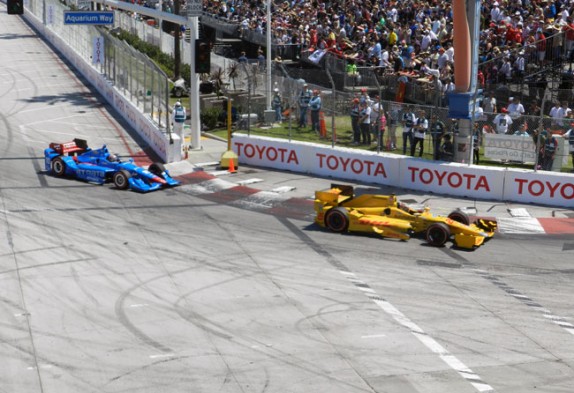
IndyCar Reality Check: Long Beach
April 24th, 2015 by JaimeB
One of America’s premiere racing events, the Toyota Grand Prix of Long Beach has been hosting open wheel racing on the streets of Long Beach, California for over 40 years. iRacing members are able to enjoy the current configuration of Long Beach as a Tech Track. This means we get all the challenges of this technical street circuit without all the King Taco banners to distract your eyes – and stomach.
When it comes to building a setup for Long Beach, there are many factors you need to take into account. In speaking with Chris Simmons, engineer for Scott Dixon’s #9 Target Chip Ganassi Racing car, he said the primary concerns with Long Beach include the curbing and bumps in the braking zones. Turns One through Nine have varying bumps throughout that drivers need to learn and think about. Any one of these curbs can upset the balance of the car and make braking a nightmare. Drivers building setups will want to spend some time working on their dampers in order to minimize the impact of these bumps.
“Any one of these curbs can upset the balance of the car and make braking a nightmare.”
Also keep in mind that certain segments of the Long Beach curbing are multi-tiered and can be dangerous to drive over. One specific piece of advice that Simmons gave was that you can take some more curb in Turn 8 in order to gain a little extra speed for the back stretch. Finally Simmons shared with me that a good idea when building a setup for Long Beach is to run a little less rear camber which will allow for increased straight-line traction. This traction will help the car manage the bumps throughout the track at the expense of some cornering ability.
In talking with a number of drivers, the main place on-track where time can be made and lost is between Turns Nine and 11. Turn 9 is at the end of the backstretch and Turn 11 is the Queen’s Hairpin. In between these two turns is Turn 10 which is a long, 180 degree corner which typically has little acceleration after the apex given that you approach Turn 11 very quickly. According to Brembo, the company that provides the brakes on the Dallara DW12, Turn 10 requires about a full second of brake application and the least amount of brake pressure of any corner on the circuit. The average car will reach about 101mph entering the braking zone and slow to about 83mph at the end of braking. This figure of 83mph is the second fastest corner on the entire circuit behind only Turn 9 (85 mph). While there are many options in terms of the line through Turn 10, racers who can manage to hold the car close to the curbing in the second half of the turn will be well-positioned for Turn 11.
In Turn 11, the average speed after braking is around 42mph and will require some trail braking in order to help the car turn. An important part of navigating Turn 11 is cutting the car close to the wall. Just how close you wonder? Ask Takuma Sato.
Finally, the best passing section of the track is Turn One, which is at the end of the longest and fastest straightaway on the circuit. The braking zone of Turn One is very long as you will decelerate from around 167 mph to 76mph in just a fraction over two seconds in the space of 332ft. You can take a bit of curbing, but be careful to not cut the corner too much because the concrete walls will sneak up on you in a hurry.

Andretti Autosport’s Ryan Hunter-Reay shows Target/Chip Ganassi Racing’s Tony Kanaan the way through Turn One.



















































